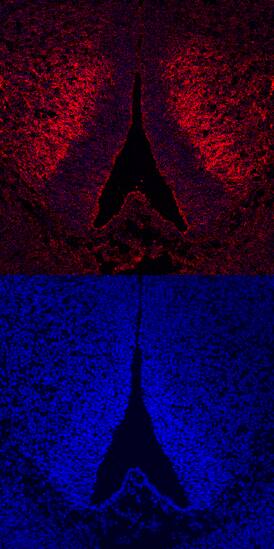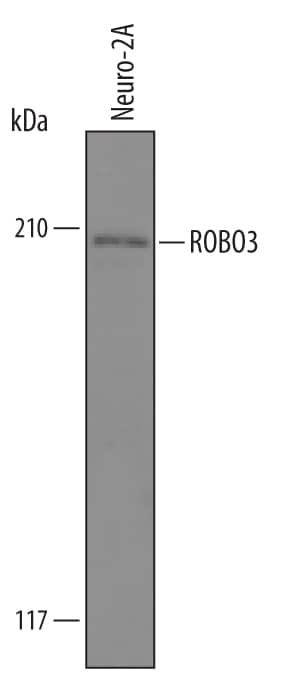Mouse ROBO3 Antibody
R&D Systems, part of Bio-Techne | Catalog # AF3155

Key Product Details
Species Reactivity
Validated:
Cited:
Applications
Validated:
Cited:
Label
Antibody Source
Product Specifications
Immunogen
Gly54-Ser545
Accession # Q9Z2I4
Specificity
Clonality
Host
Isotype
Scientific Data Images for Mouse ROBO3 Antibody
Detection of Mouse ROBO3 by Western Blot.
Western blot shows lysates of Neuro-2A mouse neuroblastoma cell line. PVDF Membrane was probed with 0.5 µg/mL of Mouse ROBO3 Antigen Affinity-purified Polyclonal Antibody (Catalog # Af3155) followed by HRP-conjugated Anti-Goat IgG Secondary Antibody (Catalog # HAF019). A specific band was detected for ROBO3 at approximately 205 kDa (as indicated). This experiment was conducted under reducing conditions and using Immunoblot Buffer Group 1.ROBO3 in Mouse Embryo.
ROBO3 was detected in immersion fixed frozen sections of mouse embryo (E11.5) using Mouse ROBO3 Antigen Affinity-purified Polyclonal Antibody (Catalog # AF3155) at 25 µg/mL overnight at 4 °C. Tissue was stained using the NorthernLights™ 557-conjugated Anti-Goat IgG Secondary Antibody (red, upper panel; Catalog # NL001) and counterstained with DAPI (blue, lower panel). Specific staining was localized to developing forebrain. View our protocol for Fluorescent IHC Staining of Frozen Tissue Sections.Applications for Mouse ROBO3 Antibody
Immunohistochemistry
Sample: Immersion fixed frozen sections of mouse embryo (E11.5)
Western Blot
Sample: Neuro‑2A mouse neuroblastoma cell line
Formulation, Preparation, and Storage
Purification
Reconstitution
Formulation
Shipping
Stability & Storage
- 12 months from date of receipt, -20 to -70 °C as supplied.
- 1 month, 2 to 8 °C under sterile conditions after reconstitution.
- 6 months, -20 to -70 °C under sterile conditions after reconstitution.
Background: ROBO3
Mouse ROBO3 (also named Rig-1) is a 200 kDa member of the ROBO family of guidance molecules (1‑3). The term ROBO derives from round-about, a description of the circuitous pathway axons take in the absence of a functional ROBO gene (3, 4). Mouse ROBO3 is a type I transmembrane glycoprotein that is synthesized as a 1366 amino acid (aa) precursor. It contains a 20 aa signal sequence, an 871 aa extracellular domain (ECD), a 21 aa transmembrane segment, and a 454 aa cytoplasmic region (5, 6). The ECD contains five C2-type Ig-like domains (aa 64‑531) and three fibronectin (FN) type III domains (aa 555‑863). The cytoplasmic region contains three of four possible 15‑20 aa long CC (conserved cytoplasmic) motifs that are found in ROBO-1 (7, 8). Mouse ROBO3 has multiple isoforms. An alternate start site generates an 1366 aa (precursor) A isoform and a 1344 aa (precursor) B isoform. These two forms only differ in the first 53 and 31 amino acids of the precursor, respectively (9). There are reportedly nine splice variants in the mouse ROBO3 gene. Three result in soluble forms. Little information exists about the isoforms. Mouse ROBO3 ECD is 95%, 84% and 86% aa identical to the ROBO3 ECD in rat, human and canine, respectively. Normally, axons originating on one side of the spinal cord are inhibited from crossing to the other side by a SLIT2-ROBO1 interaction at the midline. ROBO3 is permissive for this event. It is unclear how this is accomplished. One possibility is that it binds directly to ROBO-1, blocking SLIT activation. A second possibility involves ROBO3 binding to SLIT2 in a nonproductive interaction. In human, only ROBO3 Form B is known to bind to SLIT2 (9‑11).
References
- Rajagopalan, S. et al. (2000) Neuron 28:767.
- Guthrie, S. (2004) Curr. Biol. 14:R632.
- Guthrie, S. (2001) Curr. Biol. 11:R300.
- Seeger, M. et al. (1993) Neuron 10:409.
- Yuan, S-S.F. et al. (1999) Dev. Biol. 207:62.
- SwissProt. Accession # Q9Z2I4.
- Bashaw, G.J. et al. (2000) Cell 101:703.
- Kidd, T. et al. (1998) Cell 92:205.
- Camurri, L. et al. (2005) Mol. Cell. Neurosci. 30:485.
- Sabatier, C. et al. (2004) Cell 117:157.
- Mambetisaeva, E.T. et al. (2005) Dev. Dyn. 233:41.
Long Name
Alternate Names
Gene Symbol
UniProt
Additional ROBO3 Products
Product Documents for Mouse ROBO3 Antibody
Product Specific Notices for Mouse ROBO3 Antibody
For research use only

